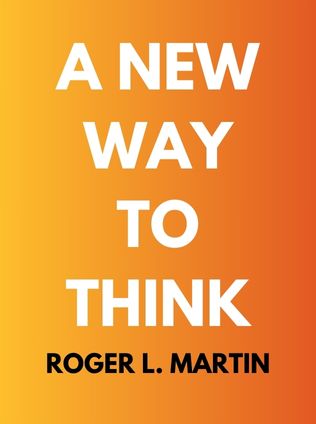
A New Way to Think
Your Guide to Superior Management Effectiveness
By Roger L. Martin
Published 05/2022
About the Author
Roger L. Martin is a distinguished academic and practitioner in the field of business and management. As the former Dean of the Rotman School of Management at the University of Toronto, Martin has had a profound influence on contemporary management practices and theories. His work spans across various facets of business, including strategy, innovation, and organizational behavior. Known for challenging conventional wisdom, Martin's insights are deeply rooted in real-world applications and his extensive research.
Main Idea
In A New Way to Think: Your Guide to Superior Management Effectiveness, Roger L. Martin critiques fourteen prevalent business models that he deems inherently flawed. He proposes alternative models that he believes offer more effective solutions to common business challenges. Martin's central thesis is that professionals should not cling to ineffective models; instead, they should continually reassess and adapt their strategies to ensure optimal outcomes. He emphasizes the need for a logical and iterative approach to model testing and refinement.
Table of Contents
- Introduction
- Rethinking Competition
- The Power of Familiarity
- Organizing Knowledge Workers
- Treating Talent Differently
- Context in Business Models
- Making Strategic Choices
- Structuring Work for Success
- Key Business Activities
- Innovation and Its Role
- The Role of Strategies
- Designing Innovation
- Capital Investment
- Mergers and Acquisitions
- Conclusion
Analyzing and Explaining Each Idea and Sub-Content
Introduction
In the introduction, Martin sets the stage for his argument against entrenched business models. He recounts a conversation with a business practitioner and an academic who both believed in the adage that superior execution of a mediocre idea is preferable to poor execution of a superior idea. Martin disagrees, stating, "with a well-executed mediocre idea, the best one can achieve is mediocrity." He argues that the core of business success lies in the effectiveness of the model itself rather than merely its execution.
Rethinking Competition
Martin's first model challenges the conventional view of competition. He asserts that "it’s not corporations that compete; it’s the products and services they offer." This shift in perspective refocuses competitive efforts from corporate hierarchy to the frontline where customer interactions occur. Martin posits that companies should "support those on the front lines" to better meet customer needs and outcompete rivals at the product level.
"The true competition does not occur at the highest levels of the company. Rather, they occur at what is often the lowest levels of an organization - where the customer actually purchases the product or service." - Roger L. Martin
Martin emphasizes that the real battleground for competition is where the customer engages directly with the product. This model requires a fundamental shift in how organizations view their internal structure. Rather than a top-down hierarchy where decisions are made at the highest levels and trickle down, Martin advocates for a structure where every level of the organization is geared towards supporting those at the frontline. This empowers employees who interact directly with customers, giving them the tools and authority to make decisions that can enhance the customer experience and, ultimately, the product’s competitiveness.
this approach include:
- Retail companies training their sales staff extensively and giving them autonomy to make decisions that can immediately benefit customers.
- Service industries where frontline employees have the ability to resolve customer issues without having to escalate them to higher management.
The Power of Familiarity
Martin critiques the incessant drive for change and rebranding in modern businesses. He uses the example of Instagram’s logo change to illustrate how familiarity can often be more beneficial than constant innovation. "The familiar solution usually trumps the perfect one," Martin writes, emphasizing the importance of stability and predictability in customer experiences.
"The mind loves automatically more than just about anything else." - Roger L. Martin
Martin's analysis of the familiarity model suggests that businesses often overlook the psychological comfort that familiarity provides to consumers. When companies frequently change their branding or product offerings, they risk alienating their customer base. Consistency in branding and product experience fosters trust and loyalty among consumers.
- Facebook’s consistent user interface compared to the chaotic design changes of MySpace, which ultimately led to its decline.
- Classic brands like Coca-Cola that have maintained a consistent brand image over decades, reinforcing customer loyalty.
By maintaining a stable and familiar user experience, companies can build a stronger connection with their customers, reducing the cognitive load and decision-making effort required from consumers.
Sign up for FREE and get access to 1,400+ books summaries.
You May Also Like
Rich Dad Poor Dad
What the Rich Teach Their Kids About Money - That the Poor and Middle Class Do Not!
By Robert T. KiyosakiFreakonomics
A Rogue Economist Explores the Hidden Side of Everything
By Steven D. Levitt and Stephen J. DubnerThe Lean Startup
How Today's Entrepreneurs Use Continuous Innovation to Create Radically Successful Businesses
By Eric RiesWho Moved My Cheese?
An Amazing Way to Deal with Change in Your Work and in Your Life
By Spencer Johnson, M.D.Factfulness
Ten Reasons We're Wrong About the World – and Why Things Are Better Than You Think
By Hans RoslingMake Your Bed
Little Things That Can Change Your Life...And Maybe the World
By William H. McRaven



















